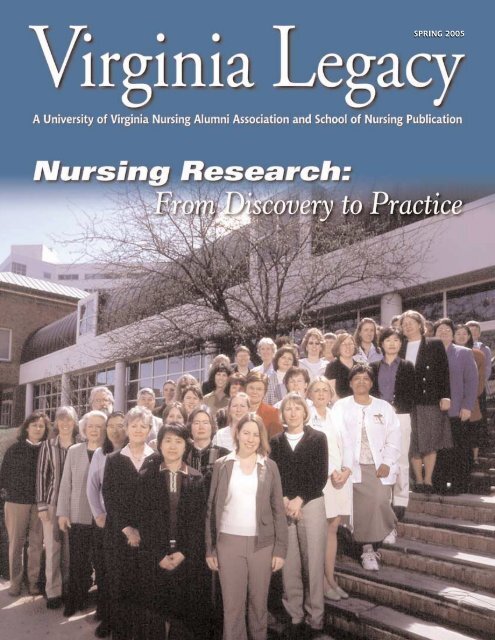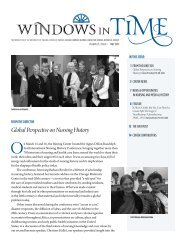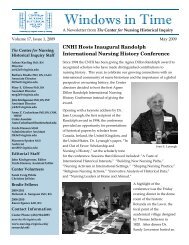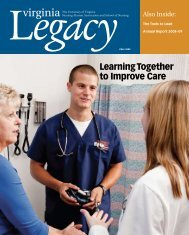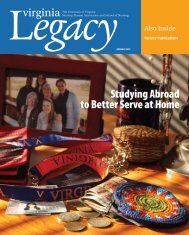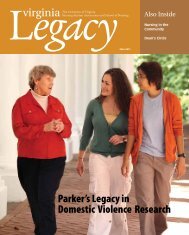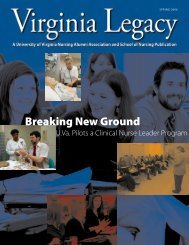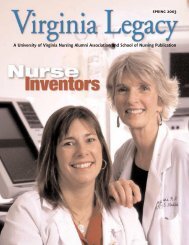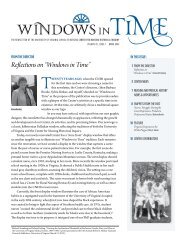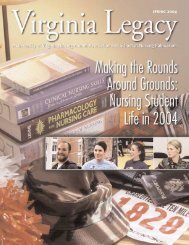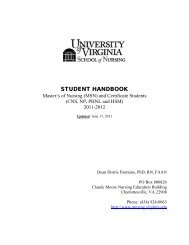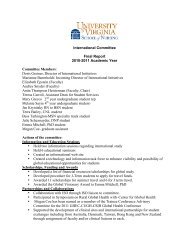Legacy 2005 Spring - School of Nursing - University of Virginia
Legacy 2005 Spring - School of Nursing - University of Virginia
Legacy 2005 Spring - School of Nursing - University of Virginia
Create successful ePaper yourself
Turn your PDF publications into a flip-book with our unique Google optimized e-Paper software.
The <strong>Virginia</strong> <strong>Legacy</strong> is published twotimes a year by the <strong>University</strong> <strong>of</strong><strong>Virginia</strong> <strong>School</strong> <strong>of</strong> <strong>Nursing</strong> and <strong>Nursing</strong>Alumni Association. Your comments,feedback, and story ideas are alwayswelcome! Please contact the editor.Thank you for your support.<strong>University</strong> <strong>of</strong> <strong>Virginia</strong><strong>School</strong> <strong>of</strong> <strong>Nursing</strong>Alumni and Development OfficeP.O. Box 800782Charlottesville, VA 22908-0782(434) 924-0138(434) 982-3699 FAXE-mail: nursing-alumni@virginia.eduEditor:Karen Jordan RatzlaffEditorial Advisers:Reba Moyer Childress, ShannonMarshall Ikenberry, Lisa Kelley,Emily Eiwen Drake, Katie Cook,Dory HulseClass Notes & News Editor:Elisangela BlevinsDesign:Richard Montoya: designContributing Writers:Kathleen Phalen Tomaselli,Cathy Eberly, Dan Heuchert,Karen Ratzlaff, Dory Hulse,Mary Blair Zakaib, Anne BromleyPhotography:Tom Cogill, Jackson Smith,Kathy Kayser, Andrew Shurtleff,Michael BaileyThe <strong>Virginia</strong> <strong>Legacy</strong> is published usingprivate funds.<strong>University</strong> <strong>of</strong> <strong>Virginia</strong> <strong>School</strong> <strong>of</strong> <strong>Nursing</strong>Established in 1901Main Switchboard: (434) 924-2743Admissions & Student ServicesToll-free: (888) 283-8703Visit us on the Web at:http://www.nursing.virginia.eduJeanette Lancaster, RN, PhD, FAANSadie Heath Cabaniss Pr<strong>of</strong>essor <strong>of</strong><strong>Nursing</strong> and Deancontents47812184 An Honorable Choice:Men in <strong>Nursing</strong>7Alumni in ActionLynn Dixon Palmer(BSN 1987)8Worth NotingNews from the <strong>School</strong> <strong>of</strong> <strong>Nursing</strong>12<strong>Nursing</strong> Research:From Discovery to Practice18<strong>Nursing</strong> Alumna Receives<strong>University</strong>’s DistinguishedAlumna AwardDepartments2 President’s Letter6 Philanthropy20 Events in Review22 Class Notes and NewsBack Cover CalendarThe <strong>Virginia</strong> <strong>Legacy</strong> SPRING <strong>2005</strong> 3
FEATUREAn Honorable Choice: Men in <strong>Nursing</strong>Of the 241 studentsenrolled in the“traditional” four-yearprogram for studentscoming directly out <strong>of</strong>high school, onlyfour are male.When he first consideredentering nursing, DanDavid heard it all. Friendswarned that he would spend his workdayslifting heavy patients. He saw sitcomsand movies where male nurseswere the butt <strong>of</strong> jokes that <strong>of</strong>tenstereotyped them as homosexuals.Now in his final year at the <strong>School</strong><strong>of</strong> <strong>Nursing</strong>, the 33-year-old father <strong>of</strong>two <strong>of</strong>ten senses surprise when he tellspatients he is a nursing student. Hecan almost see them thinking, “Isn’tnursing women’s work?”“It gets even funnier when they findout you’re a nursing student and theyask you if you want to go on to be adoctor,” he says.David, the president <strong>of</strong> U.Va.’s Menin <strong>Nursing</strong> organization, is comfortableenough to laugh <strong>of</strong>f those comments,but it’s not hard to understandwhere they originate. While women arebecoming doctors in increasing numbers—theycomprise 67 <strong>of</strong> the 140students in the U.Va. <strong>School</strong> <strong>of</strong>Medicine’s latest entering class—thefield <strong>of</strong> nursing is still overwhelminglyfemale.Of the 372 students working towarda bachelor’s degree in nursing at U.Va.,only 20 are men. The vast majority <strong>of</strong>the men are, like David, older studentsreturning to school for a seconddegree. Others are experienced registerednurses seeking to add a bachelor’sdegree to their resumes.Of the 241 students enrolled in the“traditional” four-year program for studentscoming directly out <strong>of</strong> highschool, only four are male.The second-degree students “aremore secure in who they are,” Davidsays. “It’s not easy for an 18-year-old4 The <strong>Virginia</strong> <strong>Legacy</strong> SPRING <strong>2005</strong>
FEATURE [male] to go into a predominantlyfemale field.”But it’s not for a lack <strong>of</strong> persuasion.David has heard <strong>of</strong> some Southernnursing schools that recruit men atNASCAR races. Others seek out maleswho have had a service-oriented background,such as Boy Scouts or militarycorpsmen.Luring more men into the fieldwon’t necessarily alleviate a growingnational nursing shortage. <strong>Nursing</strong>schools generally have more thanenough applicants; addressing theshortage is more a question <strong>of</strong> increasingcapacity and retention rather thanrecruitment.Theresa Carroll, the chief undergraduateadmissions recruiter at thenursing school, says bringing moremen into nursing is a question <strong>of</strong> overcomingsocial stigmas that preventmen from pursuing a field where theymight flourish.“Each <strong>of</strong> us has our talents andgifts, and shouldn’t be excluded from afield because <strong>of</strong> gender,” she says,adding rhetorically, “Why do we needmore women engineers and womenphysicians?”Nationally, men make up 8.4 percent<strong>of</strong> baccalaureate nursing students,according to the American Association<strong>of</strong> Colleges <strong>of</strong> <strong>Nursing</strong>. At U.Va., thatnumber is just 5.4 percent.The Men in <strong>Nursing</strong> group startedlast year. Its mission: to support malenursing students, to help recruit othermen, and to address health issues thatmay be more sensitive for men.U.VA. MEN IN NURSING20 current undergraduate students26 current graduate students274 male alumni (all programs)The Men in <strong>Nursing</strong> group started last year. Itsmission: to support male nursing students, to helprecruit other men, and to address health issues thatmay be more sensitive for men.One December morning, David satwith the organization’s vice president,Darroch Massie, in the lobby <strong>of</strong>McLeod Hall, and the two discussedtheir personal learning experiences.Massie worked as an emergencyroom technician about 10 years ago,and later went on to earn an associate’sdegree in science at Central <strong>Virginia</strong>Community College in Lynchburg.Now 39, he said he never considerednursing as a field until about two yearsago, despite having worked with malenurses in his ER job and having a malecousin who is a nurse.“It was one <strong>of</strong> those things thatfinally clicked,” Massie says. “Peoplegave me encouragement to go intonursing.”David earned his BS in psychologyfrom the <strong>University</strong> <strong>of</strong> Massachusetts-Amherst, and then targeted a doctoratein neuroscience. But “I really didn’tlike the fact that I didn’t get to interactwith people,” he says. So he settled fora master’s in biomedical science fromthe <strong>University</strong> <strong>of</strong> Colorado and set sailfor nursing school.Both say they find the nursingfaculty “extra supportive” <strong>of</strong> men, evenif they occasionally slip up and refer toa generic nurse as “she.”“At first I felt uneasy,” Massie says.“I was much older, and the only guy.But they were very accepting. Beingthe only guy in class, they kind <strong>of</strong>adopted me.”“I’m almost embarrassed,” Davidsays. “I’m a white male, and I’m aminority.”Once they hit the hospital floor forclinical training, they found that beingmale cut both ways with patients.Older men <strong>of</strong>ten are more comfortabletalking with other men about sensitivematters, Massie says, but “somewomen don’t want me to give them abath.”David <strong>of</strong>ten is conscious <strong>of</strong> hisresponsibility as a role model for boyshe encounters in the hospital. “Youwant to show a little <strong>of</strong> what you cando, just to show what the pr<strong>of</strong>ession islike,” he says.The nursing shortage means thatfew nurses <strong>of</strong> either gender have troublefinding work after graduation.Neither man comes across as a barrier-bustingcrusader. Instead, they arejust two guys pursuing a career theyfind to be rewarding. But if their successcan break down stereotypes, allthe better.“In the field, I hear, ‘I had a malenurse once. He was excellent,’” Massiesays, smiling.The <strong>Virginia</strong> <strong>Legacy</strong> SPRING <strong>2005</strong> 5
PHILANTHROPYAt Long Last: <strong>School</strong> <strong>of</strong> <strong>Nursing</strong> Prepares for ExpansionTHE FUNDING PICTURE(as <strong>of</strong> March 1, <strong>2005</strong>)State Appropriation - $6 million<strong>University</strong> Challenge - $2 million*<strong>School</strong> <strong>of</strong> <strong>Nursing</strong> Reserves andProvost Returns - $1.1 millionGifts and Pledges from Donors -$2.6 millionTotal commitments to date -$11.7 millionGoal - $12–14 million*The <strong>University</strong> will match dollar-for-dollar everycontribution to the project up to $2 million.Every year for the past four years,the U.Va. <strong>School</strong> <strong>of</strong> <strong>Nursing</strong> hasbeen forced to deny admissionto an increasing number <strong>of</strong> qualifiedapplicants, simply because there is notenough space in McLeod Hall toaccommodate them. At a time whenthe shortage <strong>of</strong> nurses is reaching thecrisis stage in many communitiesacross the nation, it is more than a littleironic that this nursing school hasbeen unable to accept many qualifiedyoung women and men who want nothingmore than to become a nurse.As alumni know full well, a <strong>Virginia</strong>nurse is prepared for leadership andpractice like few others.At long last, an expanded <strong>School</strong> <strong>of</strong><strong>Nursing</strong> is well on its way to becominga reality, thanks to a major appropriationfrom the Commonwealth <strong>of</strong><strong>Virginia</strong> and a corresponding challengegrant from the <strong>University</strong>.The state endorsed the school’s planto construct a $12 million companionbuilding near McLeod Hall by approvinga $6 million appropriation to theproject during the 2004 legislativesession.The <strong>University</strong> responded with itsown endorsement: a $2 million challengegrant, payable when the <strong>School</strong> <strong>of</strong><strong>Nursing</strong> raises an equal amountthrough private donations.“We are grateful for this extraordinarysupport, which will help us embarkon a venture that is vital to the future<strong>of</strong> the <strong>School</strong> <strong>of</strong> <strong>Nursing</strong> and to thefuture <strong>of</strong> health care in the Commonwealth,”says Jeanette Lancaster, dean<strong>of</strong> the school.These new funding commitmentsand other gifts and pledges fromvisionary donors have enabled theschool to select an architect for theproject. Subject to approval by the<strong>University</strong>’s Board <strong>of</strong> Visitors, theWashington, D.C., architectural firmBowie Gridley Architects could beginwork as early as April 1. The proposedthree- or four-story, 30,000 grosssquare-foot facility will be built justacross from McLeod Hall on 15thStreet. The location will increase theschool’s visibility from Lane Road andJefferson Park Avenue. The school’scurrent location, McLeod Hall, provides50,000 gross square feet, whichmust be renovated to achieve establishedgoals.Private support is essential to completeconstruction <strong>of</strong> the facility by thefall <strong>of</strong> 2008, according to David Black,head <strong>of</strong> development for the <strong>School</strong> <strong>of</strong><strong>Nursing</strong>. At the same time, the schoolwill raise funds to renovate McLeodHall since a large part <strong>of</strong> the programwill remain in the current building.“Our alumni and friends recognizethe challenges the nursing pr<strong>of</strong>essionfaces. By stepping forward now withtheir financial support, they will help toensure that their alma mater will remaina leader in the education <strong>of</strong> outstandingnurses for <strong>Virginia</strong> and the nation.”For more information on this importantproject, contact David Black at(434) 924-0138 or e-mail him atdcb6t@virginia.edu.With the addition <strong>of</strong> the companionbuilding, the school will be able to:• Increase undergraduate studentenrollment. Last year, 310 applicationswere received for the BSN program. Theschool admitted 51 and had to turnaway more than 50 fully qualifiedapplicants. Applications for <strong>2005</strong>–06total 347. An expansion will enable theschool to graduate an additional 50 to60 bachelor’s-level nurses each year.• Educate increased numbers <strong>of</strong> doctoralgraduates. These highly qualifiednurses will become important additionsto the nation’s nursing faculty, themajority <strong>of</strong> whom are now more than50 years <strong>of</strong> age.• Provide more space for fundedresearch. The new building will providespace designed to facilitate the importantresearch that faculty conduct currentlyin woefully inadequate space.Faculty research answers many questionsabout how to more effectivelycare for patients.• Create larger, more innovative, andmore flexible teaching spaces. Builtin 1972, McLeod Hall was not configuredto accommodate the highly interactiveinstruction common in nursingeducation today. The new facility willbe designed to handle student groups<strong>of</strong> varying sizes in traditional classroomsettings, as well as those engaged in awide range <strong>of</strong> health and wellnessactivities.• Incorporate the latest technologyinto the education process. The newbuilding will feature state-<strong>of</strong>-the-arttechnology to meet the needs <strong>of</strong> therapidly changing nursing field.• Create spaces designed for studentuse and leadership development.The new facility will include a StudentLife Center that will function as a “gatheringspace” where students can build astronger sense <strong>of</strong> community, currentlyunavailable in McLeod Hall.6The <strong>Virginia</strong> <strong>Legacy</strong> SPRING <strong>2005</strong>
ALUMNI IN ACTION Lynn Dixon PalmerBSN Class <strong>of</strong> 1987As Lynn Palmer was applyingfor a clinical nursing positionat the <strong>University</strong> <strong>of</strong> TexasSouthwestern Medical Center in 1990,another job opening caught her eye.“I had no idea what the responsibilities<strong>of</strong> a senior research nurse intrauma and critical care would be, butI found out that very day,” says Palmer,who had already gained experience as acharge nurse, clinic manager, andpatient care coordinator in northern<strong>Virginia</strong>. Intrigued by what she learnedduring her interview, she accepted theposition, and was soon putting herskills to work as a coordinator <strong>of</strong> clinicalprotocols for a group <strong>of</strong> the university’smedical researchers.Her career move proved to be propitious.Palmer quickly mastered thenew job, which she followed with astint in a similar position for a majordrug company. Three short years afterLynn and her mother, Connie Cooke Dixon,Diploma 1950.moving to Texas, she and another veterannurse––armed with businesssavvy, management expertise, and theenthusiasm <strong>of</strong> true entrepreneurs––decided they had something special to<strong>of</strong>fer the medical research field. Thetwo colleagues launched MedTrials,Inc., a Dallas-based clinical researchconsulting firm, to help pharmaceutical,biotech, and medical device companieswith new product testing,regulatory approval, and commercialization.MedTrials entered what has inrecent years become an estimated$16 billion growth industry. The companyvies with more than 300 competitorsfor contracts with firms racing tomeet an ever-increasing demand fornew drugs and medical devices.“The national shift from inpatientto outpatient medical care and ouraging population have fueled explosiveexpansion in the contract researchfield, and there is no end in sight,” saysPalmer, who earned an MBA fromBaylor <strong>University</strong> after co-foundingMedTrials. She serves as the company’sCEO. “It can be a very cutthroatbusiness.”It’s a business in which MedTrialshas found success. “As nurses, webring something different to the table:a focus on quality training and relationshipmanagement, an in-depthunderstanding <strong>of</strong> the clinical process,and the ability to prioritize,” she says.“I learned these analytical, assessment,and communication skills at U.Va. andused them each and every day when Iworked in a clinical setting.”Even as a young girl, Palmer knewthat she would attend the <strong>University</strong>.“I guess it’s in my blood; I never reallyconsidered another school,” she says.A daughter <strong>of</strong> medical and nursingschool graduates, she followed a pathto Charlottesville that has also beentraveled by her brother, sister, nephew,and a brother-in-law.These days, MedTrials is expandingboth nationally and internationally.The company, which currentlyemploys more than 70 people, recentlyacquired a competitor and opened an“I am convinced that my nursing educationis at the root <strong>of</strong> my success, and I would not be whereI am today without it.”East Coast <strong>of</strong>fice. Through a three-waypartnership with the ClinTrust GlobalAlliance, it has also expanded its reachoverseas, joining companies that supportcontract research activities inEurope, the Middle East, and Asia.For her part, Palmer spends a greatdeal <strong>of</strong> time on the road—<strong>of</strong>fering consultingand training services to clients,teaching in the Graduate <strong>School</strong> <strong>of</strong>Biomedical Sciences at the <strong>University</strong><strong>of</strong> North Texas, and serving as one <strong>of</strong>her industry’s best-known speakers.The wife <strong>of</strong> a physician and the mother<strong>of</strong> two young children, she also makestime to stay involved with her belovedalma mater. She is a member <strong>of</strong> the<strong>Nursing</strong> Ventures Advisory Board,whose members counsel DeanLancaster and the <strong>School</strong> <strong>of</strong> <strong>Nursing</strong>faculty on the latest developments intheir field. As a participant in last fall’sinaugural <strong>Nursing</strong> Leadership Forum,she and other alumni led discussionswith students on leadership and careerissues.“I believe U.Va. prepared me well topursue a nontraditional nursingcareer,” Palmer says. “I am convincedthat my nursing education is at theroot <strong>of</strong> my success, and I would not bewhere I am today without it.”The <strong>Virginia</strong> <strong>Legacy</strong> SPRING <strong>2005</strong> 7
Conversations inClinical EthicsSince March 2004, the <strong>School</strong> <strong>of</strong><strong>Nursing</strong> has co-sponsored aseries open to all health care pr<strong>of</strong>essionalswithin the U.Va. HealthSystem called Conversations in ClinicalEthics. Designed as an open forum todiscuss morally troubling issues withina safe environment, the series grew out<strong>of</strong> annual <strong>Nursing</strong> Worklife surveys thatidentified the continuing need for anopportunity to discuss morally distressingsituations. Sponsor partners for theseries are the U.Va. Health SystemEthics Committee and the Division <strong>of</strong>Patient Care Services. The lead facilitatorfor the series is Associate Pr<strong>of</strong>essorAnn Hamric, who works with a team <strong>of</strong>five other facilitators to manage themonthly conversations.In addition to providing needed supportfor health care pr<strong>of</strong>essionals(including physicians, nurses, physical,respiratory and occupational therapists,social workers, and chaplains), the conversationsare also an opportunity forjunior nursing faculty and students tolearn how to facilitate ethical discussions.Doctoral student Beth Epstein andClinical Instructor Sarah Delgado are two<strong>of</strong> the facilitators working with Hamricon the series.Conversations in Clinical Ethics meetsonce a month; issues such as do notresuscitate (DNR) orders, pain management,the nursing shortage as an ethicalproblem, OR utilization, caregiver stress,prejudice, and patient self-responsibilityhave been addressed. Attendance averages25 and participants have expressedappreciation for the open, honest discussionand the case presentations thatinclude possible solutions. Participantsalso noted that it has been helpful tohear from other disciplines, as they hearperspectives that they otherwise had notconsidered or understood.WorthNOTINGFaculty AchievementsPam Kulbok has recently takenon many new pr<strong>of</strong>essionalroles. She assumed thePresidency <strong>of</strong> the Association <strong>of</strong>Community Health <strong>Nursing</strong> Educatorsin June 2004. In November 2004 sheassumed leadership <strong>of</strong> the QuadCouncil <strong>of</strong> Public Health <strong>Nursing</strong>organizations (bringing together leadersfrom four national public healthnursing organizations to create aforum for exchange and collaboration).She is also a member <strong>of</strong> the AmericanNurses’ Association, PublicHealth/Community Health Scope andStandards Workgroup, which was constitutedin summer 2004.KulbokInstructor in <strong>Nursing</strong> VickiSouthall (MSN ’85) recently completedwriting the “Guidelines forSpecialized Health Care Procedures,” a456-page publication that is currentlybeing distributed to every school andhealth department in the state <strong>of</strong><strong>Virginia</strong>. She was hired by the <strong>Virginia</strong>Department <strong>of</strong> Health more than ayear ago to tackle the daunting project.Her thorough compilation <strong>of</strong> instructionswill help school and public healthnurses handle both basic and complexnursing procedures for those with specialhealth care needs. Southall wasalso recently pr<strong>of</strong>iled in the Central<strong>Virginia</strong>n for her ongoing work withstudents in rural Louisa County.Catherine Ratliff (BSN ’77) wasthe 2004 winner <strong>of</strong> the prestigiousPresident’s Award presented annuallyby the Wound Ostomy andContinence <strong>Nursing</strong> (WOCN) Societyto the person who has, either over thepast year or past several years, bestexemplified the ideals and values <strong>of</strong>the WOCN Society. Ratliff wasdescribed as “an unwavering andsteadfast advocate for advancing theevidence base for WOC nursing.”Sarah Farrell (BSN ’81, MSN ’83)was selected to participate in theAmerican Association <strong>of</strong> Colleges <strong>of</strong><strong>Nursing</strong> “Leadership for Academic<strong>Nursing</strong>” program. The year-long program,supported by the Helene FuldHealth Trust, is designed to developand enhance leadership skills in newand emerging administrators in baccalaureateand graduate nursing programs.The program includes afocused assessment experience, twoleadership conferences, and an experiencedmentor.“Federal F314 Tag-Pressure Ulcers”may not mean much to you—unlessyou or someone you love is in a nursinghome. Courtney Lyder, U.Va.Medical Center Pr<strong>of</strong>essor <strong>of</strong> <strong>Nursing</strong>,pr<strong>of</strong>essor <strong>of</strong> Internal Medicine and8 The <strong>Virginia</strong> <strong>Legacy</strong> SPRING <strong>2005</strong>
WORTH NOTING Geriatrics, andchair <strong>of</strong> theDepartment <strong>of</strong>Acute &Specialty Care,played a pivotalrole in writingthe recentlyenacted(November2004) revisionLyder<strong>of</strong> Medicareregulations thataffect 17,000 long-term care facilitiesin the United States. The new federalguidelines provide detailed instructionsfor federal and state surveyorsresponsible for compliance. Lyder, whoenjoys an international reputation forhis expertise in gerontology/geriatricsand wound care, is being sought bystate regulators and facilities ownersacross the nation to consult on thenew regulations and their compliancestrategies.The Beta Kappa Chapter <strong>of</strong> theSigma Theta Tau International HonorSociety will honor Jeanette Lancasterwith their <strong>2005</strong> Distinguished NurseAward on May 6. The award is presentedto a nurse who receives local,national, and/or international recognitionas a nursing leader, who influencesleadership in nursing through visionaryand innovative approaches, whocreates an environment that enhancesthe image <strong>of</strong> nursing, and who participatesin the development <strong>of</strong> nursingleaders and leadership.Since her arrival at U.Va. in 1989,Dean Lancaster has worked diligentlyand creatively to advance the standing<strong>of</strong> the <strong>University</strong> <strong>of</strong> <strong>Virginia</strong> <strong>School</strong> <strong>of</strong><strong>Nursing</strong>. Currently she serves as president-elect<strong>of</strong> theAmericanAssociation <strong>of</strong>Colleges <strong>of</strong><strong>Nursing</strong> and asassociate director<strong>of</strong> ClinicalServices at theU.Va. HealthSystem.Lancaster is aprolific authorLancasterand co-editor <strong>of</strong>the widely used textbook, CommunityHealth <strong>Nursing</strong>, and she has a nationaland international reputation as aspeaker at conventions and workshops.<strong>School</strong> Accreditedfor WOC<strong>Virginia</strong> Auto Dealers Supporting <strong>Nursing</strong>In December 2004, the <strong>School</strong><strong>of</strong> <strong>Nursing</strong> became one <strong>of</strong> onlynine accredited training centersin the United States for Wound,Ostomy, Continence (WOC)care. Only one other is associatedwith a university and U.Va.’sis the only one integrated into amaster’s degree program (thenew Geriatric Nurse Practitionerprogram).A recent graduate <strong>of</strong> the program,Tara Spears (MSN ’05) isone <strong>of</strong> only four WOC nurses inthe entire U.S. Army.On February 18, <strong>2005</strong>, representatives <strong>of</strong> the <strong>Virginia</strong>Automobile Dealers Association (VADA) delivered a childCPR manikin to the U.Va. Student Nurses Association (SNAV)chapter. This is the second time that SNAV has been therecipient <strong>of</strong> a VADA grant. Each year, members <strong>of</strong> SNAVteach CPR to more than 500 individuals.Shown here (L to R) JohnCates, VADA AYES statemanager; John Jessup,director <strong>of</strong> VADA EducationFoundation; Liza Borches,Volvo <strong>of</strong> Charlottesvilledealer; Doris Greiner,associate dean <strong>of</strong> AcademicPrograms; <strong>School</strong> <strong>of</strong><strong>Nursing</strong> students MeganCates and Justine Mize;and Carol Lynn Maxwell-Thompson, faculty advisorand clinical instructor.The <strong>Virginia</strong> <strong>Legacy</strong> SPRING <strong>2005</strong> 9
WORTH NOTING<strong>Virginia</strong> Health Foundation:A New Bank in TownApproved by the <strong>University</strong>’sBoard <strong>of</strong> Visitors last year, therecently formed <strong>University</strong> <strong>of</strong><strong>Virginia</strong> Health Foundation supportsthe missions <strong>of</strong> the U.Va. HealthSystem, including the <strong>School</strong>s <strong>of</strong><strong>Nursing</strong> and Medicine, the MedicalCenter, and the Health SciencesLibrary. The foundation accomplishesthese goals by raising funds for priorityneeds across the Health System andby representing the philanthropicinterests <strong>of</strong> donors. The private foundationhas the ability to receive gifts insupport <strong>of</strong> the Health System and todispense funds in accordance withdonors’ intentions. Funds investedwith the foundation will be managedby UVIMCO, the <strong>University</strong>’s investmentarm.Student Nurses Assume State LeadershipDuring the <strong>Virginia</strong> <strong>Nursing</strong> Student Association (VNSA)convention in Charlottesville in February, four U.Va. studentswere elected to the VNSA Board <strong>of</strong> Directors.“<strong>Nursing</strong> alumni and friendscan be certain that any giftearmarked for the <strong>School</strong> <strong>of</strong>(L to R) Lindsey Jones, Betty Shumaker, Elizabeth Talley, Justine Mize<strong>Nursing</strong> and deposited withthe foundation will benefit thenursing school, in accordancewith the donor’s wishes.”A volunteer board comprisingrepresentatives from each area (nursing,medicine, hospital) who hail fromthe private sector lead the foundation,and the deans <strong>of</strong> nursing, medicine,and the CEO <strong>of</strong> the medical centerserve as ex-<strong>of</strong>ficio members.Currently, private giving providesmore support for the <strong>University</strong> <strong>of</strong><strong>Virginia</strong> than the state itself provides.In managing these private funds for theHealth System, the foundation takes ona major role in the life <strong>of</strong> the institution.Elizabeth Talley (BSN ’06) was electedpresident, Betty Shumaker (BSN ’06) asfirst vice-president, Lindsey Jones (BSN’07) as secretary, and Justine Mize (BSN’07) as editor <strong>of</strong> the Torch, the newsletter<strong>of</strong> VNSA. U.Va. students also hostedthe statewide convention (see eventphoto on page 20).“<strong>Nursing</strong> alumni and friends can becertain that any gift earmarked for the<strong>School</strong> <strong>of</strong> <strong>Nursing</strong> and deposited withthe foundation will benefit the nursingschool, in accordance with the donor’swishes,” explains David Black, assistantvice president for Health SystemDevelopment–<strong>Nursing</strong>. “Essentially,the foundation is a new bank for someIn April <strong>2005</strong>, fifteen nursing studentswill be attending the NationalStudent <strong>Nursing</strong> Association (NSNA)convention in Salt Lake City, Utah.Conventions give students a wonderfulopportunity to meet with other leadersfrom across the United States.<strong>School</strong> <strong>of</strong> <strong>Nursing</strong> accounts.” For thetypical nursing donor, there will be noimmediate change in how gifts aremade, received, deposited, managed,and/or stewarded at the <strong>University</strong>.If you have questions, call Black at(434) 924-0138 or e-mail him atdcb6t@virginia.edu.10 The <strong>Virginia</strong> <strong>Legacy</strong> SPRING <strong>2005</strong>
Reunions <strong>2005</strong>Come home to U.Va.May 16-18The Thomas Jefferson SocietyWe invite graduates<strong>of</strong> the Classes <strong>of</strong> 1955 tocelebrate this 50th milestone.Much may have changed, but some corevalues remain the same! Reconnect withyour comrades, come see what the<strong>School</strong> <strong>of</strong> <strong>Nursing</strong> is like today, meet thedean, and hear her vision for an excitingfuture. Remember why you are so proudto be a <strong>Virginia</strong> nurse.Visit www.uva50.org.The registration packet you receivedby mail and the Web site provide acomplete schedule for both events.Questions? Contact HeatherHightower at the <strong>School</strong> <strong>of</strong> <strong>Nursing</strong> byphone at (434) 982-0645 or by e-mailat hightower@virginia.edu.June 3-5We invite graduates <strong>of</strong> 1960,’65, ’70, ’75, ’80, ’85, ’90, ’95,’00 to celebrate.Return to the school and see what haschanged—and what hasn’t. Reconnectwith your comrades over lunch and witnessthe presentation <strong>of</strong> nursing alumniawards. Relax in the charming garden <strong>of</strong>Pavilion II, home <strong>of</strong> Dean Lancaster, overbrunch. Remember why you are soproud to be a <strong>Virginia</strong> nurse.Visit www.virginiareunions.comThe <strong>Virginia</strong> <strong>Legacy</strong> SPRING <strong>2005</strong> 11
COVER STORY<strong>Nursing</strong> Research:From Discovery to Practice<strong>Nursing</strong> research isunique. In contrast tomedical research, it seeksto improve quality <strong>of</strong> lifeand patient health,rather than seeking tocure disease.Dr. Phyllis Verhonick instructs a nursing student in laboratory research skills.The effect <strong>of</strong> the murder <strong>of</strong> oneparent by the other, called uxoricide,on children is immediateand devastating. In a single act achild loses both parents—one dies andthe other is in custody or a fugitivefrom the law.<strong>School</strong> <strong>of</strong> <strong>Nursing</strong> researchers wantto know what happens to the children<strong>of</strong> uxoricide. They’re asking now-grownsurvivors, “Please, tell me your story.”“What happens to kids when oneparent kills the other is a very complexbereavement issue,” says Rick Steeves(FNP ’96), associate pr<strong>of</strong>essor andprincipal investigator <strong>of</strong> the ParentalHomicide Study at the <strong>School</strong> <strong>of</strong><strong>Nursing</strong>, funded by the NationalInstitutes <strong>of</strong> Health (NIH). Steeveshas spent his career researchingbereavement and anguish. “Nurses arein a unique position to explore thenature <strong>of</strong> human suffering.”<strong>Nursing</strong> research is unique. In contrastto medical research, it seeks toimprove quality <strong>of</strong> life and patienthealth, rather than seeking to curedisease.“A great deal <strong>of</strong> nursing research isfocused on promoting health, preventingillness, alleviating pain and suffering,and maximizing recovery,” saysJeanette Lancaster, Sadie HeathCabaniss Pr<strong>of</strong>essor and dean <strong>of</strong> theschool. “It enables nurses to learn anddevelop best practices for care <strong>of</strong>patients; it is directly and imminentlyfocused on improved outcomes, interventions,preventions, and improved care.”Proven SuccessThe $750,000 Parental HomicideStudy was one <strong>of</strong> 521 NationalInstitutes <strong>of</strong> Health (NIH) fundedresearch endeavors undertaken bynursing faculty and students in thiscountry in 2003.Based on funding from the prestigiousNIH, the <strong>School</strong> <strong>of</strong> <strong>Nursing</strong> was16th in the nation for funded proposalsin 2003, up from 28 a year earlier.“We made a special effort to increasethe number <strong>of</strong> proposals to NIH…ourfaculty and students are very passionateabout their work and about makinga difference,” says Elizabeth Merwin,associate dean for research. “For example,obtaining funding for the RuralHealth Care Research Center thisyear—$1.4 million over five years—required a two-year investment upfront by many <strong>of</strong> our faculty members.”Merwin also points out the remarkablesuccess <strong>of</strong> the school’s doctoralstudents in obtaining NationalResearch Service Awards (NRSAs), afederally funded grant that requires asmuch time from the faculty mentor asany other grant she or he might receive.U.Va. students currently have thethird-highest number <strong>of</strong> NRSA fellowshipsin the nation, with one-fourth <strong>of</strong>doctoral students having received anaward.In the last five years, the school’sresearch and training programs havebeen awarded $10.3 million. “We’revery proud <strong>of</strong> the research we do at the12 The <strong>Virginia</strong> <strong>Legacy</strong> SPRING <strong>2005</strong>
COVER STORYC<strong>School</strong> <strong>of</strong> <strong>Nursing</strong>. Our faculty involvegraduate and undergraduate studentsin their projects whenever possible,”says Lancaster. “Research should bethe foundation on which <strong>University</strong>faculty base their teaching.” Thus, studentsbenefit from teachers who areresearchers and faculty benefit by generatingnew knowledge; grants bringresources into the school as well asrecognition and prestige. A school withactive faculty researchers helps toattract and retain strong faculty colleaguesand capable students, particularlygraduate students.The Next GenerationBeing able to learn about and conductresearch initially drew KathrynLaughon (BSN ’98, MSN ’99), nowassistant pr<strong>of</strong>essor <strong>of</strong> nursing, to the<strong>University</strong> <strong>of</strong> <strong>Virginia</strong>. But it was herpartnership with Barbara Parker whilean undergraduate student that set heron her current career path. Parker, pr<strong>of</strong>essorand director <strong>of</strong> the doctoral program,passed on her knowledge andresearch interest––violence againstwomen—to Laughon when sheenrolled in a graduate-level researchcourse. “I asked her, as an undergraduatestudent, what can I do?” saysLaughon. Parker got her involved withthe school’s Southeastern RuralMental Health Research Center. Witha <strong>Nursing</strong> Alumni AssociationSummer Research Fellowship, Laughonbegan exploring the predictors <strong>of</strong> violence.She went on to earn a PhD atJohns Hopkins <strong>University</strong> andreturned to U.Va. last year.Now working together again as coinvestigatorson the uxoricide study,Parker and Laughon are trying to discoverhow people respond to this trauma.The Parental Homicide study beganlast January and is ongoing. Researchershave interviewed 47 adults who aschildren witnessed a parent die at thehands <strong>of</strong> the other. When one parentkills the other, the children fall intoResearch Centers at the U.Va.<strong>School</strong> <strong>of</strong> <strong>Nursing</strong>Center for the Study <strong>of</strong>Alternative andComplementary TherapiesDirector: Dr. Ann Gill TaylorSoutheastern Rural MentalHealth Research CenterDirector: Dr. Emily HauensteinCenter for <strong>Nursing</strong> HistoricalInquiryDirector: Dr. Arlene KeelingRural Health Research CenterDirector: Dr. Elizabeth MerwinMore information is available at:www.nursing.virginia.edu/centerslegal limbo, neither victim norassailant. Often lost in a maze <strong>of</strong>funerals and warring families, the childrenare never asked to tell their story.“We find the majority have lived severalplaces after the homicide, movingfrom family member to family member,”says Parker.The researchers are asking theirquestions in hopes <strong>of</strong> finding out whatmight help. “At this point we don’t know.But I’m interested in the policy implicationsand how to improve systems,”says Laughon. “At some point, we maybe able to provide guidelines for decisionsmade around these children.”On the cover: More than 50 researchers and research staffare pictured, but they represent only a fraction <strong>of</strong> thoseinvolved in the nursing research enterprise at U.Va.Where it All BeganIn 1968 an Army Nurse Corps coloneljoined the nursing school faculty andthe seeds <strong>of</strong> this research legacy wereplanted. A researcher herself, retiredLt. Col. Phyllis Verhonick set the nursingschool on a progressive path, makingit one <strong>of</strong> the first schools in thenation to <strong>of</strong>fer an undergraduateresearch course. First as director <strong>of</strong>research then as acting dean, she gotstudents and faculty excited about newpossibilities.“The students loved her; she wasvivacious and funny,” says Pr<strong>of</strong>essorEmeritus Barbara Brodie, associatedirector <strong>of</strong> the Center for <strong>Nursing</strong>Historical Inquiry. “She was one <strong>of</strong> thefirst fellows <strong>of</strong> the American Academy<strong>of</strong> <strong>Nursing</strong> to be recognized for hercontributions to nursing research,”says Brodie.How did this change nursing?It moved nursing from empiricalpractice to research-based. “It was amonumental step. Up to that time,nursing was task-oriented,” says Brodie.“Phyllis and her colleagues began toset the foundation for the doctoral program(later established in 1982) and toattract doctoral-prepared faculty. Sheput the school on a path <strong>of</strong> nursingresearch that would help documentwhat is effective and efficient clinicalpractice.”continued on page 14The <strong>Virginia</strong> <strong>Legacy</strong> SPRING <strong>2005</strong>
Current DoctoralResearch ProjectsMary O’Laughlen—”ImprovingAsthma Outcomes in Children: A Pilot,”funded by an NIH fellowship and sponsoredby Dr. Patricia Hollen.Cheryl Dumont—”Blood Pressure andRisks <strong>of</strong> Cardiac Catheterization,” fundedby an NIH fellowship and sponsored byDr. Arlene Keeling.Irma Mahone—”Medication DecisionMaking by Persons with Serious MentalIllness,” funded by an NIH fellowshipand sponsored by Dr. Elizabeth Merwin.Deirdre Thornlow—”Relationship <strong>of</strong>Patient Safety to Patient Outcomes,”funded by an NIH fellowship and sponsoredby Dr. Elizabeth Merwin.Sarah Anderson—”Evidentiary InjuryFindings after Sexual Assault,” funded byan NIH fellowship and sponsored by Dr.Barbara Parker.continued from page 13Changing LivesMany other U.Va. research projectsalso seek to improve lives and haveproven results. For a number <strong>of</strong> yearsEmily Hauenstein, director <strong>of</strong> theSoutheastern Rural Mental HealthResearch Center, has been workingwith rural depressed women. Since1994, Hauenstein and colleagues havebeen helping depressed women gain anunderstanding <strong>of</strong> the causes <strong>of</strong> stress,anxiety, and develop self-help skillsincluding cognitive restructuring andrelaxation techniques. “Hauensteinsends clinical specialists into thewomen’s homes,” says Merwin. “Herself-help tools for depression havebeen so helpful that the women arenow teaching their friends.” Currently,Hauenstein is funded by NIH toexamine treatment <strong>of</strong> mental healthproblems, factors that affect obtainingfields (PEMF) on reducing the symptoms<strong>of</strong> pain, fatigue, sleep disturbances,and depression in postmenopausalwomen with rheumatoid arthritis; andcranial stimulation for chemotherapysymptoms in breast cancer.“Dr. Taylor is studying interestingthings such as massage therapy andthe use <strong>of</strong> magnets to reduce pain,”says Merwin.Dr. Arlene Keeling, director <strong>of</strong>the school’s history center, has beenfunded by the National Library <strong>of</strong>Medicine for a three-year study toinvestigate the history <strong>of</strong> prescriptiveauthority in nursing, 1900 to present.These and many other outstandingresearch initiatives have enhancededucational programs for the nextgeneration. Since Phyllis Verhonick’sfirst research class more than threedecades ago, the <strong>School</strong> <strong>of</strong> <strong>Nursing</strong> hassoared to become one <strong>of</strong> the mosthighly ranked nursing schools in theNancy Jallo—”Effect <strong>of</strong> RelaxationTapes on Maternal Stress: A Pilot,” fundedby an NIH fellowship and sponsoredby Dr. Ann Gill Taylor.Diana Taibi—”Effect <strong>of</strong> Valerian Rooton Sleep in Rheumatoid Arthritis,” fundedby an NIH fellowship and sponsoredby Dr. Ann Gill Taylor.Tusana Thaweekoon—”CommunityViolence on Adolescent AdjustmentProblems,” funded by an AmericanNurses Foundation fellowship and sponsoredby Dr. Pamela Kulbok.Karen Rose—”Effect <strong>of</strong> CranialElectrical Stimulation on ElderlyCaregivers’ Subjective Appraisal,Depressive Symptoms, and SleepDisturbances,” funded by an AmericanAcademy <strong>of</strong> <strong>Nursing</strong> scholarship andsponsored by Dr. Emily Hauenstein.For more details on these DoctoralStudent Projects, visit www.nursing.virginia.edu/centers/cnr/Ann Gill Taylortreatment, and comparing outcomes <strong>of</strong>treatment to those who do not receivetreatment.Perhaps some <strong>of</strong> the most adventurousstudy is conducted by the Centerfor the Study <strong>of</strong> Complementary andAlternative Therapies. Researchers, ledby Ann Gill Taylor, go beyond theWestern model <strong>of</strong> allopathic medicine,exploring energy, herbs, and bodymanipulation. They explore the effectiveness<strong>of</strong> alternatives to traditionalpain relief like electrical stimulation onosteoarthritis <strong>of</strong> the knee; the effects<strong>of</strong> low strength pulsed electromagneticRESEARCH AND TRAINING GRANTFUNDING SNAPSHOTOctober 2003–September 2004Faculty and Student Grants Funded: 30Dollar Amount <strong>of</strong> All Funded Grants: $3,906,646Faculty Grants Currently Funded by NIH:9 Grants among 6 Principal Investigatorsnation. Research brings resources andhelps improve the infrastructure <strong>of</strong> theschool.“In a palpable way, our research providesthe vital spirit that animates ourschool, though we are careful not tobecome complacent in our success,”says Lancaster. “To that end, theschool has begun concentratingresearch efforts in the areas <strong>of</strong> agingand oncology, two future directionsshaped in close alignment with our colleaguesin the <strong>School</strong> <strong>of</strong> Medicine andthe U.Va. Health System.”14The <strong>Virginia</strong> <strong>Legacy</strong> SPRING <strong>2005</strong>
FROM THE BOARDROOM Apply for the AlumniScholarshipThe <strong>Nursing</strong> Alumni Association ispleased to fund a $2,500 scholarshipto support continued nursing educationat any institution. All U.Va. nursingalumni who are enrolled in adegree-granting program are eligibleto apply. Annual deadline: June 1.Funding for this scholarship ismade possible by the generosity <strong>of</strong>alumni and friends who make gifts tothe <strong>Nursing</strong> Annual Fund.You can download an applicationfrom the Web at www.nursing.virginia.edu/alumniand click on“Alumni Scholarship.” Or call (434)924-0138 or e-mail nursingalumni@virginia.eduto request anapplication.Alumni Council ElectionVotes will be cast on June 4 at the annual business meeting <strong>of</strong>the <strong>Nursing</strong> Alumni Association for the election <strong>of</strong> the president.If you cannot attend the meeting but would like to cast your vote,please return this ballot by June 4 to the U.Va. <strong>School</strong> <strong>of</strong> <strong>Nursing</strong>,Alumni & Development Office, PO Box 800782, Charlottesvile VA22908-0782. Or e-mail your vote to nursing-alumni@virginia.edu.❒ PresidentCindi Colyer Allen, BSN 1970, Richmond, <strong>Virginia</strong>(re-election to a second three-year term)Allen has worked as a clinician and community volunteer and is amother <strong>of</strong> three. Over the years, she has contributed countless hoursto the <strong>Nursing</strong> Alumni Association in a wide variety <strong>of</strong> roles and forvarious projects. She has also been an active volunteer with BetaKappa Chapter <strong>of</strong> Sigma Theta Tau.Join the Cause!VOLUNTEER!If you want to get involved with the <strong>School</strong> <strong>of</strong> <strong>Nursing</strong> or <strong>Nursing</strong>Alumni Association, consider these:• JOIN OUR LOCAL ALUMNI VOLUNTEER LIST(we’ll call on you when we need extra hands).• BECOME A CLASS ADVOCATE(network and communicate with classmates).• SERVE ON THE VIRGINIA LEGACY EDITORIAL BOARD(help plan the content <strong>of</strong> this magazine).• SERVE ON THE NURSING ALUMNI COUNCIL(determine the direction <strong>of</strong> the association).• SCREEN SCHOLARSHIP APPLICATIONS, ALUMNI AWARDNOMINATIONS, OR SERVE IN OTHER CAPACITIES ON AD HOCCOMMITTEES OF THE ALUMNI COUNCILFor more information on any <strong>of</strong> these opportunities, visitwww.nursing.virginia.edu/alumni on the Web, e-mailnursing-alumni@virginia.edu, or call (434) 924-0138.The <strong>Virginia</strong> <strong>Legacy</strong> SPRING <strong>2005</strong> 15
FROM THE BOARDROOMNurses and NarrativeWith 30-hour work weeks ontop <strong>of</strong> rigorous class schedules,nursing students havelittle time to process and analyze whatthey encounter on the units. That’swhy Jeanne Erickson, an oncologynurse who teaches in the <strong>School</strong> <strong>of</strong><strong>Nursing</strong>, started a creative writing contestto give students “a place to ventand unload.”The contest has inspired prose andpoetry ranging from the comedic tothe tragic. They come from students<strong>of</strong> all ages, from 19 to 49.Now in its third year, the contestattracts the work <strong>of</strong> students who submitpoems and essays each December.Lisa Russ Spaar, director <strong>of</strong> U.Va.’screative writing program, and twonursing pr<strong>of</strong>essors judge the work. Thecontest is funded by the <strong>School</strong> <strong>of</strong><strong>Nursing</strong> Alumni Association.“The contest not only encouragesstudents to express themselves, butalso educates the public about whatnurses do on a daily basis,” saysErickson.And there’s an added benefit, saidJosie McElroy (BSN ’03, MSN ’05),whose essay won in 2003. “It fostersour ability to think creatively. We learnhow to apply that to become betternurses through reflection and throughour relationships with our patients andpeers. To me, that’s the real prize.”This year’s winners were LauraWatkins (BSN ’08) and MatthewSmith (BSN ’05), who took secondplace.To read the winning entries in theirentirety, visit www.nursing.virginia.eduand click on “current students” tab.Abbreviated version <strong>of</strong> Handwashing, by Laura WatkinsI sometimes find myself perplexed when I try to explain to people what itmeans to be a second-degree nursing student. “Well,” I say, “I’m getting myBSN, but I’m not really a true undergraduate, since I already have onebachelor’s degree.”“Ah,” say the people, “but you had a medical background in your firstdegree, so the BSN is at least building on that.”“Not really,” I reply. “Two months before I arrived at the <strong>School</strong> <strong>of</strong><strong>Nursing</strong>, I was writing papers on poetic Romanticism and the role <strong>of</strong> deconstructiveliterary theory. …”The response to this revelation varies, from congratulations on myprogress to undisguised horror that ex-English majors are allowed to wanderthe hospital halls… Nonetheless, the next question invariably is, howdo second-degree students handle the transition? …In answer, I tell themthe story <strong>of</strong> my very first clinical day.The first clinical rotation for second-degrees is “Care <strong>of</strong> the ChildbearingFamily,” or in plain language, the OB floor. Now, understand that after twoweeks <strong>of</strong> intense class training, I went into clinic with an idealized notion <strong>of</strong>myself as Super Student Nurse. …On this first day, then, my entire clinical group worked on the postpartumsection, in order to allow our instructor to keep an eye on all <strong>of</strong> us.This excellent lady walked us through reports, and then began handing outpatient assignments. Mine was a 33-year-old lady who had just had herthird child and was reportedly very agitated, for the baby had been taken tointensive care for a suspected seizure. My confidence dissipated.“Oh wow,” I whispered to one <strong>of</strong> the RNs, as the patient treatment planswere printing. “I’m so nervous. This lady is already so anxious, and she’snot going to feel any better if I go in there and faint.”The nurse squeezed my arm. “Don’t get yourself in a panic before youeven go into the room. Take deep breaths, smile nicely, and if you get flusteredtake a little break to wash your hands. It’ll reassure the patient andgive you time to think about what comes next.” She gave me a little pushtowards the room. “Remember, you’re taking care <strong>of</strong> this woman. She wantsto trust you. Now get in there and get some vital signs.”I swallowed hard, took a deep breath, and pushed open the door. Thepatient was lying in bed watching TV, with her husband seated beside her.“Mrs., um, T?” I stammered. “My name is...” I blanked momentarily, thenrecovered. “...Laura. I’m a student nurse.” Mrs. T nodded, and looked atme expectantly. I remembered that I was supposed to get vital signs. “Ineed to take your blood pressure. Now then, where is that cuff?” It was noton the wall, as it had been in the model orientation rooms. I rummagedthrough the various wires and machines, without success.continued on page 1716 The <strong>Virginia</strong> <strong>Legacy</strong> SPRING <strong>2005</strong>
FROM THE BOARDROOM continued from page 16“But before I do that,” I said brightly to Mrs. T, “I’ll washmy hands.” I crossed to the sink and flipped on the water.Mrs. T spoke up from the bed. “So, you’re a studentnurse? Have you been in school long?”“No, not too long.” I said, scrubbing furiously and scanningthe room for the missing BP cuff. “I just arrived in<strong>Virginia</strong> a month ago, as a matter <strong>of</strong> fact.”“Oh,” said she. There was a pause. “Do you like nursingso far?”The basin was filled with suds, and soap bubbles driftedthrough the air. I was running out <strong>of</strong> stall time. “Oh yes,” Isaid. “I love it.”The door creaked open, and the RN I had spoken topopped her head in. “Everything all right in here?”“Just fine.” I said, feeling as though I might drop at anymoment. “Just washing up. Gonna be nice and clean for thevital signs.” I laughed weakly.“Good thinking. Here, let me check and make sure you’reclean enough.” I wobbled to the door and held out myhands. “Very good.” she said, but she was not looking at me.I followed her gaze, and only then saw the vital signs cart,with thermometer and blood pressure apparatus, parkedagainst the wall. The nurse met my eyes and smiled.“Proper handwashing is essential.” she said, loud enough forMrs. T to hear. “Cleanliness is one sign <strong>of</strong> a good nurse.”She scooted the cart toward me with her foot. “And confidenceis another,” she said to me in a low voice. “Don’tworry, you’ll get some <strong>of</strong> that soon enough. Now fetch mesome vital signs.”She winked and was gone, and I opened up the Velcrocuff. “Hold your arm straight and at heart level for me,please. How is your pain? Are you feeling all right otherwise?”People always laugh when they hear this story, but in away, the humor falls flat for me. That paralyzed, overwhelmed,fish-out-<strong>of</strong>-water feeling is one I hadn’t felt in along time, and oddly, it’s one I hope never to forget. If I canfeel so terrorized after weeks <strong>of</strong> training, how must poorMrs. T have felt, not knowing what had happened to herbaby or what was being done to him? I was the lucky onein that room, because I had an intelligent and sympatheticmentor on hand to save my ignorant butt. My patient, however,had only me. She relied on me and trusted me to lookout for her, and with a little learning and a little luck, I wasable to do so.I cared for many patients throughout the course <strong>of</strong> thatclinical, and though they were different in their problemsand needs, I soon saw that they all looked up to and trustedtheir nurses. And at the end <strong>of</strong> it all, I came to realize thatto keep that trust intact, to warrant the faith and belief <strong>of</strong>the patient, is both the responsibility and the reward <strong>of</strong> thenurse.Library Resources for AlumniLicensed online books, journals and databases are restricted by vendors tocurrent U.Va. faculty, students, and staff, so the Claude Moore HealthSciences Library has created a Web page that includes links to various freelyavailable online resources.Responding to inquiries from both nursing and medical alumni and noting that“Learning never ends,” Linda Watson, the library’s director continued, “Alumnirelied on our library when they were students, and we want to continue the relationshipby providing a portal to help them find useful and freely available healthrelatedinformation on the Internet.”Information for visiting the Claude Moore Health Sciences Library is also provided.Visit the Web at www.healthsystem.virginia.edu/internet/library/portal/alumni/.The <strong>Virginia</strong> <strong>Legacy</strong> SPRING <strong>2005</strong> 17
FROM THE BOARDROOM<strong>Nursing</strong> Alumna Honored by <strong>University</strong><strong>2005</strong> Distinguished Alumna Award RecipientDenise Geolot ShererSherer’s commitmentto excellence isreflected in herinternationalreputation, and themany ways she hasbeen honored.For the third time in the history<strong>of</strong> the award, a nursing alumnahas been selected by theWomen’s Center to receive the<strong>University</strong>’s Distinguished AlumnaAward.The <strong>2005</strong> recipient is Denise GeolotSherer (BSN ’70, ENP ’75), a leader innursing and health policy whoseintegrity, creativity, and expertise arerespected by all who know her. Formore than 30 years, she has helpedprovide a safety net <strong>of</strong> quality servicesthat are relied on by millions <strong>of</strong> peopleacross the nation. Denise Geolot significantlyshapes the quality and availability<strong>of</strong> health care provided to allAmericans.As director <strong>of</strong> the Division <strong>of</strong><strong>Nursing</strong> in the Health Resources andServices Administration (HRSA),Geolot's work makes a daily differencein the lives <strong>of</strong> some <strong>of</strong> the UnitedStates’ most vulnerable individualsand families. The Division <strong>of</strong> <strong>Nursing</strong>plays a leadership role in ensuringthere is adequate supply and distribution<strong>of</strong> qualified nurses to meet thehealth care needs <strong>of</strong> the nation.She administers the Federal programthat provides comprehensive,flexible, and effective support for nursingworkforce development. Theprogram supports basic and advancednursing education programs, facultydevelopment, diversity programstargeting minority and disadvantagednursing students, grants to enhancepatient care and improve the workenvironment, scholarships, traineeships,loans, and nursing workforceanalysis.Her influence is seen throughnurses working in rural communities,where HRSA has established coordi-nated care systems to serve local residents.And it is felt at the earlieststages <strong>of</strong> life, where nurses work withindividuals to ensure healthy births,and to make sure that pregnant womenhave access to the health care theyrequire.Denise Geolot distinguished herselfas a leader in the health field early inlife. At the <strong>University</strong> <strong>of</strong> <strong>Virginia</strong>,where she received her nursing baccalaureatedegree with distinction in1970, she was a charter member <strong>of</strong> thenursing honor society, Sigma ThetaTau, Beta Kappa chapter. She obtaineda master’s degree at the <strong>University</strong><strong>of</strong> Colorado and returned toCharlottesville as an instructor inthe <strong>School</strong> <strong>of</strong> <strong>Nursing</strong>.After establishing her credentials asan exceptional teacher and clinician,Geolot joined forces with Dr. RichardEdlich, a plastic surgeon on the medicalfaculty, to address a serious deficitin the medical system––emergencycare for critically ill and injuredpatients. In the early 1970s little wasknown about emergency medicine,hospital emergency rooms were poorlystaffed, and the practice <strong>of</strong> rotatingphysician coverage <strong>of</strong>ten left the ERnurses trying to cope with seriously illand injured patients until a physiciancould be contacted. They first focusedtheir efforts on the problem <strong>of</strong> how tosafely and quickly transport patients toa medical facility. Working closely withcommunities, physicians, and hospitalsin Central <strong>Virginia</strong>, Edlich and Geolotdeveloped an emergency medical systemthat has now been replicatedthroughout the nation.To ensure that each rescue squadworker was adequately prepared, theycreated new educational programs that18 The <strong>Virginia</strong> <strong>Legacy</strong> SPRING <strong>2005</strong>
FROM THE BOARDROOM The <strong>Legacy</strong> Lives OnCommencement is just around the corner. If youhave not yet made a gift to the <strong>Nursing</strong> Annual Fund thisyear, please consider doing so in honor <strong>of</strong> the graduating<strong>Nursing</strong> Class <strong>of</strong> <strong>2005</strong>.Gifts received by June 30, <strong>2005</strong> are used next year to support futuregenerations <strong>of</strong> nurses and help sustain our excellent faculty.The <strong>Nursing</strong> Annual Fund is composed solely <strong>of</strong> private supportby generous alumni, parents, and friends <strong>of</strong> the school. It is the onlyunrestricted resource available to the dean to fund emerging needsthroughout the year.Recent graduates (1997-2004) can join the Dean’s Circle giftclub with a donation <strong>of</strong> $250, which is usually reserved for $1,000 +contributions. To find out more, please contact Anca DiGiacomo at(434) 984-1589 or email her at Anca@virginia.edu.taught them how to quickly initiateemergency care to stabilize and transportpatients to medical facilities.To deal with the lack <strong>of</strong> qualifiedemergency medical and nursing staffin ERs, Geolot and Edlich developed afederally funded innovative EmergencyNurse Practitioner program that placednurses with advanced training in thecare and management <strong>of</strong> emergencypatients into understaffed and remotecommunity hospitals in <strong>Virginia</strong> andother states. This was the first university-basedEmergency Nurse practitionerprogram in the nation, andGeolot served as its director from 1975to 1977, and coordinated the school’sthree other nurse practitioner programs:Pediatric, Family, and Adult.Her sterling work gained her anational reputation, and she wasrecruited to serve as a consultant inthe government’s Department <strong>of</strong>Health and Human Services. Shequickly advanced, being named deputydirector <strong>of</strong> the Division <strong>of</strong> <strong>Nursing</strong>. In2000, Denise Geolot became one <strong>of</strong>the few candidates to be named director<strong>of</strong> the Division <strong>of</strong> <strong>Nursing</strong> fromwithin the organization’s ranks.Currently, Denise Geolot is thespokesperson <strong>of</strong> nurses nationwide.She testified before Congress on thenursing shortage and she frequentlyconsults abroad. Her commitment toexcellence is reflected in her internationalreputation and the many waysshe has been honored. She received aLifetime Achievement Award from theNational Organization <strong>of</strong> Nurse PractitionerFaculties, and she is a fellow inthe American Academy <strong>of</strong> <strong>Nursing</strong>.An active alumna, Geolot was recognizedby the <strong>Nursing</strong> AlumniAssociation with a DistinguishedAlumna award in 1985, and aCentennial Heritage Award in 2001;the Raven Society inducted her in2000. She provides ample service tothe <strong>University</strong> <strong>of</strong> <strong>Virginia</strong>, as a formermember <strong>of</strong> the Health SciencesAdvisory Board, supporting theBarbara Brodie Scholar Awards andthe work <strong>of</strong> the Center for <strong>Nursing</strong>Historical Inquiry, and leading a partnership<strong>of</strong> ten successful women toestablish the RN-BSN LeadersEndowed Scholarship to help nursesattain bachelor’s degrees.The award will be presented toGeolot on April 22, <strong>2005</strong>, in theRotunda Dome Room.Two other nursing alumnae whohave been similarly honored areRebecca W. Rimel (BSN ’73) andretired Rear Admiral Mariann Stratton(BSN ’81).The <strong>Virginia</strong> <strong>Legacy</strong> SPRING <strong>2005</strong> 19
EVENTSIN REVIEW1123DECEMBER 2, 2004 – An informal reception was organized by Susan Gregory Landin (BSN ’69) inRichmond, <strong>Virginia</strong>, to honor Antoinette Cheape Button (Diploma ’28), now in her early 90s.JANUARY 14, <strong>2005</strong> – Karen Donckers Doherty (Diploma ’63) hosted a lunch for nursing alumnifrom the Newark, Delaware, region. Shown here: Mary Beth Knight (<strong>School</strong> <strong>of</strong> <strong>Nursing</strong>), NancyProckiw (Diploma ’59), Karen Doherty, Elsie Craig (BSN ’60), Sharon Larson (BSN ’89), and AnneGates (BSN ’94).FEBRUARY 4–5, <strong>2005</strong> – The Student Nurses Association <strong>of</strong> <strong>Virginia</strong> (SNAV) hosted the <strong>Virginia</strong><strong>Nursing</strong> Student Association (VNSA) Convention at the Omni Hotel in Charlottesville. More than300 students from across <strong>Virginia</strong> attended. Speakers from the <strong>School</strong> <strong>of</strong> <strong>Nursing</strong> and Health Systemincluded Dean Jeanette Lancaster, Dr. Ann Hamric, Dr. Valentina Brashers, Holly Edwards, PamCipriano, and Dr. Dorothy Tullmann.245FEBRUARY 19, <strong>2005</strong> – SNAV sponsored the first “Make a Wish” fundraising dinner at the Boar’sHead Inn in Charlottesville. More than 100 guests attended the dinner, where Dean JeanetteLancaster served as MC. Lindsay Adkins, a fourth-year nursing student, organized the successful event.FEBRUARY 18–20, <strong>2005</strong> – The <strong>School</strong> <strong>of</strong> <strong>Nursing</strong> hosted the first Diversity Weekend. Fourteen studentsfrom area colleges and universities and working nurses contemplating graduate study visitedU.Va. The event, co-sponsored by the Medical Center, the Office <strong>of</strong> Graduate Studies, and theschool’s Diversity Committee, included a welcome reception at Pavilion II, area tours, a jazz concertand other events in addition to formal and informal presentations about U.Va.’s graduate nursingprograms.267MARCH 15–16, <strong>2005</strong> – <strong>School</strong> <strong>of</strong> <strong>Nursing</strong> faculty and students said “thanks” to the alumni andfriends who support their work. Shown here: Emily Wood (BSN ’06) was one <strong>of</strong> 20 faculty andstudent callers who spent an evening on the phone. The next day, 38 students sent more than 300handwritten notes with a similar theme.MARCH 17, <strong>2005</strong> – U.Va. nurse practioners made new connections and reinforced existing ones atan alumni reception during the <strong>Virginia</strong> Council <strong>of</strong> Nurse Practitioners conference in Williamsburg.One <strong>of</strong> the early nurse practitioner graduates, Myra Lindquist (PNP ’74) won the raffle for acoveted copy <strong>of</strong> “Mr. Jefferson’s Nurses.”34520 The <strong>Virginia</strong> <strong>Legacy</strong> SPRING <strong>2005</strong>
The <strong>School</strong> <strong>of</strong> <strong>Nursing</strong> Invites You to Two Important PresentationsHuman Experimentation:From Tuskegee 1932 to Rural <strong>Virginia</strong> <strong>2005</strong>”April 27, <strong>2005</strong>3:00-4:00 pmNewcomb Hall Theatrereception to followPark in the visitor parking garageon Emmet StreetSpeaker: Dr. Mary Starke HarperDr. Harper is a pioneer, scholar, researcher, policy maker, editor, and geropsychiatricresearch consultant/clinician. She is the last surviving health care member<strong>of</strong> the Tuskegee Syphilis Study. Dr. Harper has been a moving force behindtoday’s greater protection <strong>of</strong> human subjects in research studies.Sponsored by the school’s Diversity Committee.For more information, contact Courtney Lyder at (434) 982-3298.The Catherine Strader McGehee Memorial Lecture“Story Medicine”May 2, <strong>2005</strong>2:30-3:30 pmMcLeod Auditoriumreception to followPark in the visitor parking garagenear the hospitalSpeaker: Dottie Kluttz, BSN ’66When we are born we are given our name and our very own life story. Retellingthat story has the potential to calm, to restore and even to heal. You can utilizethis healing art <strong>of</strong> story medicine in your pr<strong>of</strong>ession by learning to listen withyour heart.Kluttz is the "story keeper" at Hospice Savannah in Savannah, Georgia.Building on her nursing education and career as an educator and clinician, she wasinspired to create this position by memories <strong>of</strong> her father telling stories, herinvolvement with the storytelling movement, and her research into the power <strong>of</strong>stories to heal. She has presented her work at regional and national conferences.EVENTS IN REVIEW, continued67The <strong>Virginia</strong> <strong>Legacy</strong> SPRING <strong>2005</strong> 21
CLASS NOTES AND NEWS1940s’44 Diploma Ruth ReedChitwood <strong>of</strong> Wytheville, VA, wasrecently honored by theWytheville Rotary Club with thePaul Harris Fellow Award recognizingher life <strong>of</strong> service to thecommunity through medicine,education, and church.1960s’63 BSN <strong>Virginia</strong> ChristianTierney <strong>of</strong> Waynesboro, VA, participatedin the first <strong>Nursing</strong>Leadership Forum organized bythe <strong>School</strong> <strong>of</strong> <strong>Nursing</strong> onDecember 4, 2004. She retired aspr<strong>of</strong>essor emeritus from thePiedmont <strong>Virginia</strong> CommunityCollege in June 2004.’64 BSN Anne DuVal Frost <strong>of</strong>Pelham, NY, participated in thefirst <strong>Nursing</strong> Leadership Forumorganized by the <strong>School</strong> <strong>of</strong><strong>Nursing</strong> on December 4, 2004.She is an associate pr<strong>of</strong>essor atthe College <strong>of</strong> New Rochelle andfounder and president <strong>of</strong> theNurses’ Network <strong>of</strong> America. Sheprivately practices psychotherapyand works in the community presentingprograms on eating disorders,effects <strong>of</strong> media violence,therapeutic storytelling, and parentingstrategies.’66 BSN Dottie Kluttz <strong>of</strong> TybeeIsland, GA, participated in thefirst <strong>Nursing</strong> Leadership Forumorganized by the <strong>School</strong> <strong>of</strong><strong>Nursing</strong> on December 4, 2004.After 11 years working as aHospice nurse, Dottie created aninnovative position as “storykeeper” three years ago atHospice Savannah. She conductsinterviews with Hospice patientsto create written transcript andaudio recording for their families.’69 BSN Joan MacKechnie <strong>of</strong>Memphis, TN, is a nursing pr<strong>of</strong>essorat Southwest TennesseeCommunity College.1970s’70 BSN Carolyn C. Lavecchia<strong>of</strong> Richmond, VA, participated inthe first <strong>Nursing</strong> LeadershipForum organized by the <strong>School</strong> <strong>of</strong><strong>Nursing</strong> on December 4, 2004. Asan attorney at Williamson &Lavecchia, LC, she concentratesin the areas <strong>of</strong> medical negligenceand representation <strong>of</strong> health careproviders before the HealthRegulatory Boards. Prior to hercareer as a lawyer, she was thedirector <strong>of</strong> the Family NursePractitioner program at <strong>Virginia</strong>Commonwealth <strong>University</strong> (formerlyMCV), and practiced as anurse practitioner for eight years.’74 BSN, ’81 MSN Norah S.Knutsen <strong>of</strong> Kents Store, VA, participatedin the first <strong>Nursing</strong>Leadership Forum organized bythe <strong>School</strong> <strong>of</strong> <strong>Nursing</strong> onDecember 4, 2004. She is thefounder and president <strong>of</strong> MatureOptions, where she guides elderclients and their families throughthe health care maze.’74 BSN Michele TorranceTarbet <strong>of</strong> Rancho Santa Fe, CA,is CEO <strong>of</strong> Grossmont Hospital inLa Mesa. She was one <strong>of</strong> fourCEOs awarded an inauguralSURE Award for Supply ChainExcellence from HealthcarePurchasing News. The CEOswere honored for the way theysupport, understand, respect andencourage materials managementpr<strong>of</strong>essionals. Michele is also amember <strong>of</strong> the <strong>School</strong> <strong>of</strong> <strong>Nursing</strong>Advisory Board.’76 BSN Kathryn L. Pierce <strong>of</strong>Atlanta, GA, participated in thefirst <strong>Nursing</strong> Leadership Forumorganized by the <strong>School</strong> <strong>of</strong><strong>Nursing</strong> on December 4, 2004.She is the director <strong>of</strong> ClinicalQuality Programs at CIGNAHealthCare Southeast Region.’77 BSN Patricia McClearyWang <strong>of</strong> Menlo Park, CA, participatedin the first <strong>Nursing</strong>Leadership Forum organized bythe <strong>School</strong> <strong>of</strong> <strong>Nursing</strong> onDecember 4, 2004. She is a staffnurse on the Post AnesthesiaCare Unit at Lucile PackardChildren’s Hospital at Stanford.Patty travels to Nicaragua everysummer as a volunteer RN teammember <strong>of</strong> “Operation Rainbow,”an organization that does freeorthopedic surgery on children inLatin America.’79 BSN Aviva Zuk Share <strong>of</strong> FortLauderdale, FL, was among theattendees at the Stars and StripesBall for President Bush’s inaugurationat the Washington, D.CConvention Center in January<strong>2005</strong>.1980s’81 BSN, ’86 MSN, ’88 ANPKate Fitzgerald <strong>of</strong> Frederick,MD, participated in the first<strong>Nursing</strong> Leadership Forum organizedby the <strong>School</strong> <strong>of</strong> <strong>Nursing</strong> onDecember 4, 2004. She is seniordirector at The Advisory BoardCompany. Kate works directlywith hospital staffs throughoutthe nation, implementing bestpractices in operational efficiency,workforce management, clinicaloperations and strategy.CONTACT USNWRITE A LETTER / SEND A NOTE / SHARE YOUR NEWSON THE WEB: www.nursing.virginia.edu/alumniBY E-MAIL: nursing-alumni@virginia.eduBY FAX: (434) 982-3699BY MAIL:Use the enclosed envelope or send to <strong>School</strong> <strong>of</strong> <strong>Nursing</strong> Alumni & DevelopmentOffice, PO Box 800782 • Charlottesville, VA 22908-0782YOU CAN ALSO UPDATE YOUR ADDRESS ONLINE AT WWW.HOOSONLINE.COM’81 BSN Stacey Joyce <strong>of</strong> UpperMontclair, NJ, is a founding partnerat Health Help NJ, LLC, acompany <strong>of</strong>fering assistance inthe management <strong>of</strong> a serious illness.In addition to disease managementservices, her companyhas developed The HealthHelper, a medical organizer inwhich patients can create, store,and manage their own medicalrecords.’83 BSN, ’86 FNP Dyan Aretakis<strong>of</strong> Batesville, VA, was recognizedby the Charlottesville DailyProgress as one <strong>of</strong> 12 “DistinguishedDozen” this year. Dyanis the founder and director <strong>of</strong> theTeen Health Center at U.Va. Thearticle featuring her work waspublished on December 26, 2004.’83 BSN, ’90 MBA Sherri J.Miller <strong>of</strong> Mechanicsville, VA, participatedin the first <strong>Nursing</strong>Leadership Forum organized bythe <strong>School</strong> <strong>of</strong> <strong>Nursing</strong> onDecember 4, 2004. She iscurrently the vice president <strong>of</strong>Product and Market Managementat Health ManagementCorporation. She is responsiblefor strategic planning and implementationrelated to overall productand market strategies.’83 BSN Sandra BurwellNowell <strong>of</strong> Chester, VA, participatedin the first <strong>Nursing</strong>Leadership Forum organized bythe <strong>School</strong> <strong>of</strong> <strong>Nursing</strong> onDecember 4, 2004. She is a qualitymanagement nurse at McGuireVeterans Administration MedicalCenter in Richmond, <strong>Virginia</strong>.She is also a consultant to Homeand Community Care, PrimaryCare & Emergency ServicesAreas, and Compensation andPension.’86 BSN Colleen L. Corish <strong>of</strong>Mount Pleasant, SC, participatedin the first <strong>Nursing</strong> LeadershipForum organized by the <strong>School</strong> <strong>of</strong><strong>Nursing</strong> on December 4, 2004. Asa clinical director at theOncology/Medical SurgicalServices, Medical <strong>University</strong> <strong>of</strong>South Carolina and HollingsCancer Center, she is responsiblefor six medical/surgical andoncology inpatient units, the22 The <strong>Virginia</strong> <strong>Legacy</strong> SPRING <strong>2005</strong>
CLASS NOTES AND NEWS hemapheresis service, radiationoncology services, and theSupportive and Palliative Careprogram.’87 BSN Lynn D. Palmer <strong>of</strong>Dallas, TX, participated in thefirst <strong>Nursing</strong> Leadership Forumorganized by the <strong>School</strong> <strong>of</strong><strong>Nursing</strong> on December 4, 2004.She is the CEO and one <strong>of</strong> thefounding partners <strong>of</strong> MedTrials,Inc., a clinical research consultingfirm that helps pharmaceutical,biotech, and medical devicecompanies research and developnew products. See pr<strong>of</strong>ile onLynn on page 7.’88 BSN, ’91 MSN SusanCallicott <strong>of</strong> Bethesda, MD,graduated from John Hopkins<strong>University</strong> with her MBA in 2004.1990s’96 BSN, ’00 MSN/MBAPamela Baker DeGuzman <strong>of</strong>Charlottesville, VA, participatedin the first <strong>Nursing</strong> LeadershipForum organized by the <strong>School</strong><strong>of</strong> <strong>Nursing</strong> on December 4,2004. As the director <strong>of</strong>Medical/Surgical clinics at theU.Va. Medical Center, she hasfiscal, operational, and regulatoryresponsibility for 20 outpatientclinics and more than 100employees. On February 3, <strong>2005</strong>,she and husband Darryl welcomedtheir second daughter,Claire Elizabeth, who joins sisterZoe.’97 BSN Rick Carpenter <strong>of</strong>Charlottesville, VA, participatedin the first <strong>Nursing</strong> LeadershipNeed Help Paying for Medical Expenses?Forum organized by the <strong>School</strong> <strong>of</strong><strong>Nursing</strong> on December 4, 2004. Asa patient care services manager atthe Medical ICU, U.Va. Hospital,Rick is responsible for the leadershipand management <strong>of</strong> a 16-bedmedical ICU. He is also responsiblefor performance improvementactivities and maintains an activerole in clinical research.’97 BSN, ’04 MSN Tracey Turner<strong>of</strong> Appomattox, VA, and husbandJohn H. Turner welcomed thearrival <strong>of</strong> their new baby, JohnBrayden Turner, on December 12,2004.2000sU.Va. <strong>School</strong> <strong>of</strong> <strong>Nursing</strong> alumni are encouraged to applyfor assistance from the Tabitha S. Grier Medical AssistanceFund. There are no age restrictions, but the funds must beused for personal medical expenses not covered by insurance,Medicare, or Medicaid. The annual deadline forapplications is August 1.You can download guidelines and an application from theWeb at www.nursing.virginia.edu/alumni then click on“Grier Medical Assistance Fund.” Or call (434) 924-0138or e-mail nursing-alumni@virginia.edu to request anapplication.’01 BSN, ’02 MSN BridgetKuczkowski Leary <strong>of</strong>Charlottesville, VA, participatedin the first <strong>Nursing</strong> LeadershipForum organized by the <strong>School</strong> <strong>of</strong><strong>Nursing</strong> on December 4, 2004.Currently a post-masters familynurse practitioner student, she isalso an adjunct instructor at<strong>Virginia</strong> Commonwealth<strong>University</strong> for an undergraduatecommunity health nursingcourse. At U.Va. she also works asan assistant to Reba Childress,leading the skills lab for secondyearstudents.’03 BSN Melanie Denny, activemilitary, was one <strong>of</strong> five RNs whoserved at the 67th CSH, Mosul,Iraq, a post with more than 6,000U.S., coalition, and Iraqi soldiersand civilians. Over the course <strong>of</strong>her time in Iraq, Melanie sent e-mails to the school describing herexperience. In January she wrotethat she was grateful to be returningsafely to Germany.’04 BSN Debra Brosnihan <strong>of</strong>Washington, DC, was featured onher local NBC news affiliate stationin January <strong>2005</strong>. She waspreparing to leave for BandaAceh, Indonesia, to be part <strong>of</strong> aTsunami relief effort withNorthwest Medical Teams.IN MEMORIAM’28 Diploma Maitland AylorBarksdale <strong>of</strong> Vienna, VA, diedFebruary 2, <strong>2005</strong>.’38 Diploma Sarah CunninghamMann <strong>of</strong> Camden, ME, diedJanuary, <strong>2005</strong>.’39 Diploma Roberta G. Justis <strong>of</strong>Herndon, VA, died January 17,<strong>2005</strong>.’52 Diploma Jean P. Potter <strong>of</strong>Bethesda, MD, died January 16,2004.’56 Diploma Nancy V. Bock <strong>of</strong>Bridgeport, WV, diedDecember 9, 2004.’62 Diploma Loretta S. Griffith<strong>of</strong> Shreveport, LA, diedNovember 24, 2004.’64 BSN Jo Anne Powell <strong>of</strong>South San Francisco, CA, diedJanuary 31, <strong>2005</strong>.’66 BSN Martha D. Finnen <strong>of</strong>Cranford, NJ, died February 12,<strong>2005</strong>.’75 BSN Janice B. Martin <strong>of</strong>Madison, MS died July 20, 2004.(Friend <strong>of</strong> <strong>Nursing</strong>)’34 BA, ’35 MAMortimer Y. Sutherland, Jr. <strong>of</strong>North Garden, VA, died onJanuary 24, <strong>2005</strong>.FACULTY PUBLICATIONSFarrell, Sarah P., & Rigney,Dawn B. (<strong>2005</strong>). From dream toreality: How a parish nurse programis born, Journal <strong>of</strong> Christian<strong>Nursing</strong>, 22(2) (<strong>Spring</strong>), 34–37.Hollen, Pat J., Gralla R.J., LiepaA.M., Symanowski, J.T., &Rusthoven, J.J. (2004). Adaptingthe Lung Cancer Symptom Scale(LCSS) to mesothelioma: Usingthe LCSS-Meso conceptualmodel for validation. Cancer,101(3), 587–595.Hollen, Pat J., Gralla, R.J., &Rittenberg, C.N. (2004). Quality<strong>of</strong> life as a clinical trial endpoint:Determining the appropriateinterval for repeated assessmentsin patients with advanced lungcancer. Supportive Care in Cancer,12, 767–773.Hollen, Pat J., R.J. Gralla, R.J.M.G. Kris, M.G., McCoy, S., &Moinpour, C.M. (<strong>2005</strong>). A comparison<strong>of</strong> visual analogue andnumerical rating scale formats forthe Lung Cancer Symptom Scale:Does format affect patient ratings<strong>of</strong> symptoms and quality <strong>of</strong> life?Quality <strong>of</strong> Life Research, 14(3),807–818.Keyes, E. F., & Kane, CatherineF. (2004). Belonging and adapting:Mental health <strong>of</strong> Bosnianrefugees living in the UnitedStates. Issues in Mental Health<strong>Nursing</strong>, 25, 809–831.Parker, Barbara, & Steeves,Rick. (<strong>2005</strong>). The nationalresearch service award: Strategiesfor developing a successful proposal.Journal <strong>of</strong> Pr<strong>of</strong>essional<strong>Nursing</strong>, 21 (January–February),23–31.Wenzel, J., Utz, Sharon W.,Steeves, Rick, Hinton, Ivy. &Jones, R.A. (<strong>2005</strong>). “Plenty <strong>of</strong>sickness”: Descriptions byAfrican Americans living in ruralareas with type 2 diabetes. TheDiabetes Educator, 31(1), 98–107.Faculty names are in boldface.The <strong>Virginia</strong> <strong>Legacy</strong> SPRING <strong>2005</strong> 23
HEADERCALENDAR OFEVENTSAPRIL22 U.Va. Women’s Center Distinguished AlumnaAward (see page 18)23 Alumni Council and Advisory Board Meetings27 Diversity Committee Presentation: “HumanExperimentation: From Tuskegee 1932 to Rural<strong>Virginia</strong> <strong>2005</strong>” (see invitation, page 21)MAY2 Catherine Strader McGehee Lecture: “StoryMedicine” (see invitation, page 21)3 Classes End6 Beta Kappa Chapter <strong>of</strong> Sigma Theta Tau –Distinguished Nurse Award Dinner6–14 Examinations16–18 Thomas Jefferson Society Reunions for the Class <strong>of</strong>1955 and earlier21 <strong>School</strong> <strong>of</strong> <strong>Nursing</strong> Pinning & Hooding Ceremonies22 <strong>University</strong>’s Final ExercisesJUNE3–5 Reunions! Undergraduate classes <strong>of</strong> 1960, ’65,’70, ’75, ’80, ’85, ’90, ’95, ‘00AUGUST24 Classes BeginOCTOBER8 Alumni Council and Advisory Board Meetings8 Benefactor’s DinnerNOVEMBER2 Zula Mae Baber Bice Memorial Lecture19–27 Thanksgiving BreakDECEMBER6 Classes End8–16 ExamsInterested in Pursuing Your Masters?Want to specializein Geriatric nursing?GNP/Master’s and on-linePost-Master’s optionsSummer, <strong>Spring</strong> and FallAdmissionsSubstantial financial aid is availablefor full and part-time students.For more information, see our Website at www.nursing.virginia.eduor call toll-free (888) 283-8703.<strong>Legacy</strong> Publication Schedule ChangesA Note from the Editor:We will continue to publish the <strong>Virginia</strong> <strong>Legacy</strong> twice a year, but wenow produce this magazine in the winter and spring (January andApril). Each fall, you should receive the school’s annual report.Watch for us in your mailbox, and please share any thoughts,feedback, or ideas you have with the editorial staff!You can also stay abreast <strong>of</strong> timely news from the <strong>School</strong> <strong>of</strong><strong>Nursing</strong> by subscribing to our new electronic newsletter, Charts &Paths, sent every other month via e-mail. Sign-up atwww.nursing.virginia.edu/alumni/ChartsPaths.Thanks for reading. We work hard to produce a quality magazine,and hope you enjoy what you see.Karen J. Ratzlaff, EditorE-mail: ratzlaff@virginia.eduPhone: (434) 924-0138Nonpr<strong>of</strong>it Org.U.S. PostagePAIDPermit No. 232Charlottesville, VAMcLeod Hall, P.O. Box 800782Charlottesville, VA 22908-0782Change Service Requested


